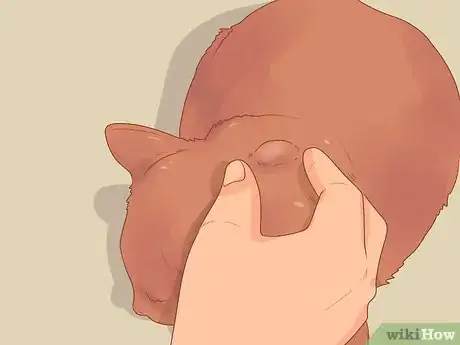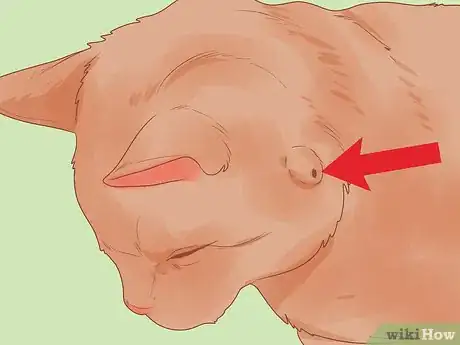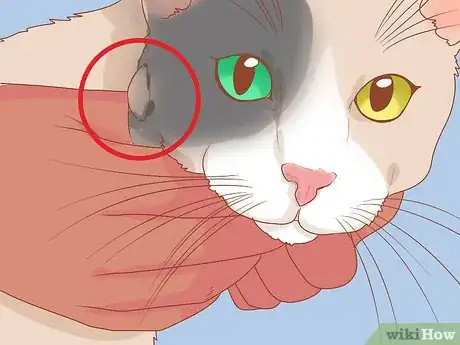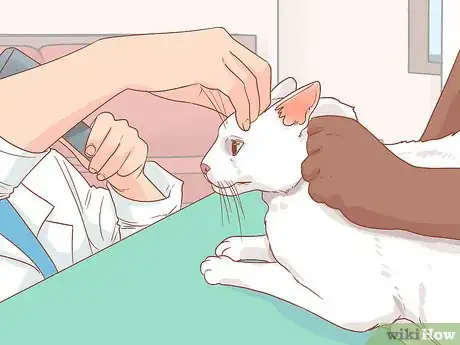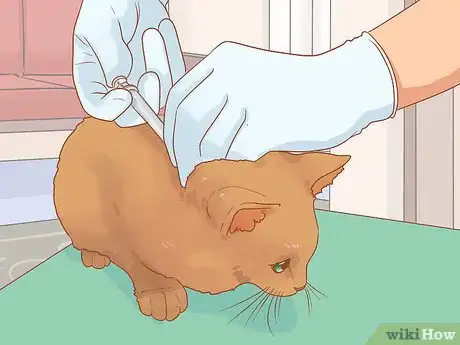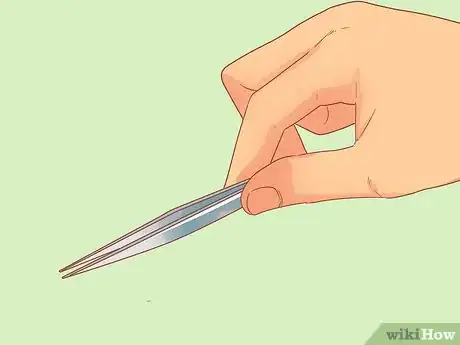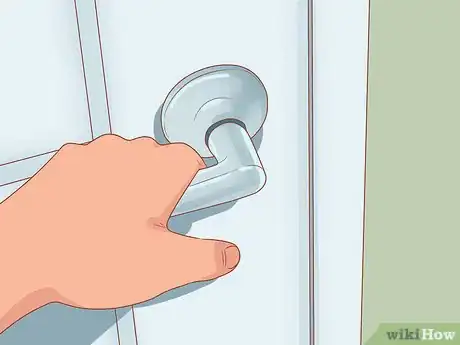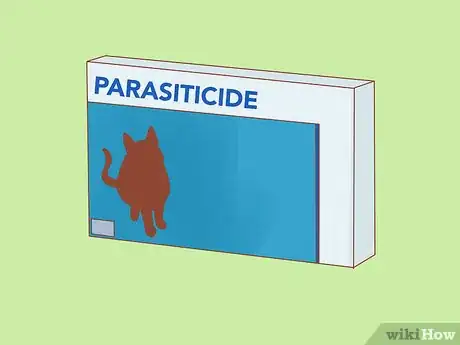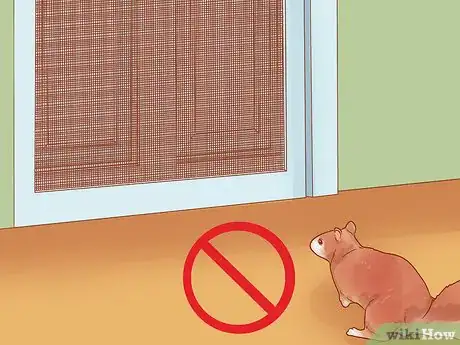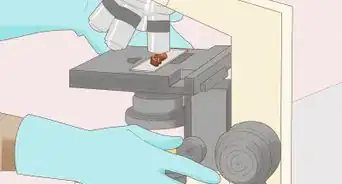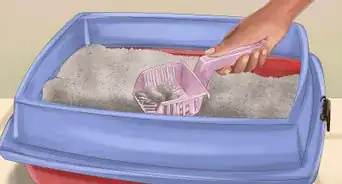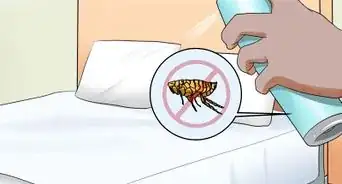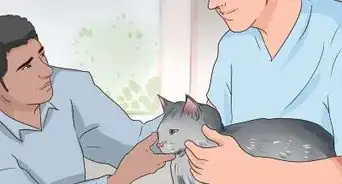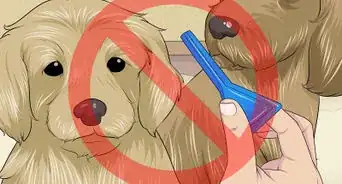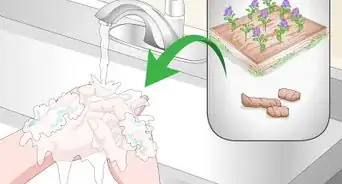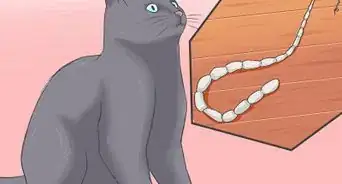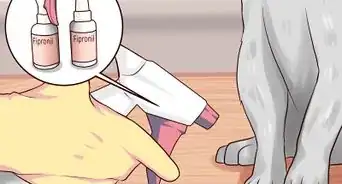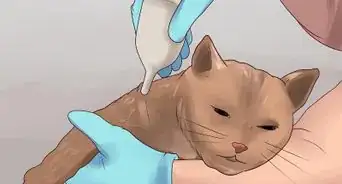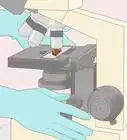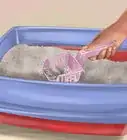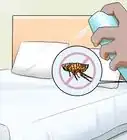This article was co-authored by Deanne Pawlisch, CVT, MA. Deanne Pawlisch is a Certified Veterinary Technician, who does corporate training for veterinary practices and has taught at the NAVTA-approved Veterinary Assistant Program at the Harper College in Illinois and in 2011 was elected to the board of the Veterinary Emergency and Critical Care Foundation. Deanne has been a Board Member of the Veterinary Emergency and Critical Care Foundation in San Antonio, Texas since 2011. She holds a BS in Anthropology from Loyola University and an MA in Anthropology from Northern Illinois University.
wikiHow marks an article as reader-approved once it receives enough positive feedback. In this case, 87% of readers who voted found the article helpful, earning it our reader-approved status.
This article has been viewed 80,891 times.
A “warble” is a nontechnical term of identification for a botfly (Cuterebra) larva. These small, worm-like larvae live in burrows on the ground and can enter a cat’s body through nose, mouth, or anus. Then, the warble crawls through the cat’s body until it nears the skin, where it creates a small hole to breathe through while it grows and matures within the cat. This process can be itchy and uncomfortable for cats.[1] Warbles should be removed by a veterinarian, so if you suspect that your cat has a warble, schedule an appointment as soon as possible.
Steps
Identifying Warbles in Cats
-
1Look and feel for swellings beneath the skin. Although warbles are not evident immediately after they enter a cat’s body, they can be seen and felt once they’ve formed a shallow burrow under your cat’s skin. These will look like small lumps to the naked eye. They’re also palpable: if you’re petting a cat and feel a small lump beneath its skin, you may have found a warble.[2]
- Many species of Cuterebra live throughout North America. They reside primarily in southern Canada and throughout the United States, but botflies can also be found in Mexico and tropical regions of Central America.
- If you live outside of these regions, it’s unlike that your cat has contracted a warble.
-
2Inspect the swelling for a breathing hole. Once the warble makes a small burrow under your cat’s skin, it will puncture a tiny breathing hole. These are visible if you look closely. You’ll be able to see a very small hole in the middle of the raised bump. And, if the warble has grown inside of your cat and is almost ready to emerge, the breathing hole will also enlarge.[3]
- Look for warbles around the head and neck of your cat. Although the warbles can burrow to other regions of a cat’s body and create their breathing holes there, they most often live in cats’ head and neck.
Advertisement -
3Notice any empty cysts in your cat’s skin. If you didn’t notice the warble while it was living in your cat’s skin, you may find the empty cyst once the larva has pushed itself out. Cysts can easily become infected—especially if the cat has been scratching, licking, or gnawing at the warble—and can also turn into open abscesses in the cat’s flesh.[4]
- The cyst is essentially a small open wound. Don’t fall under the misconception that the problem is “solved” if the warble has dropped out of your cat. You still need to take the animal to a veterinarian, who will clean the cyst and prescribe an antibiotic.
Treating a Cat’s Warbles
-
1Take your cat to a veterinarian. Rather than attempting to remove the warble yourself, schedule a prompt appointment with your vet. A veterinary doctor will be able to confirm the diagnosis, and take the proper steps to both remove the warble from your cat’s flesh and cleanse the wound so that the cat does not risk infection.[5]
- While warbles can have serious health consequences for your cat (including death, in the case of severe infection), they’re not considered a medical emergency.
-
2Anesthetize the cat. Depending on the depth of the warble, the veterinarian may need to fully anesthetize or sedate your cat. The vet will then surgically widen the warble’s breathing hole, in order to have better access to the larva inside.[6] This process will need to be done in a sterile environment, without you in the room.
- Alternately, if the cat is docile and the warble is near the surface of the skin, the cat may not need to be fully sedated or anesthetized. The vet may be able to use a local anesthetic only on the portion of the cat that contains the warble.
-
3Draw the warble out using tweezers. Once the warble’s breathing hole in the cat’s skin is large enough for the vet to access, they’ll use a pair of sterile tweezers to reach inside and extract the full warble.[7] The cat will not feel any pain during this process, since it will be sedated or locally anesthetized.
- It’s important that the veterinarian remove the entire warble from your cat’s flesh. If the warble rips in half and part stays in the cat’s skin, this can lead to serious infection or allergic reaction.
- Vets will likely give your cat Capstar to kill the parasite prior to removing the cuterebra.
-
4Clean or flush the cyst. Once the veterinarian has removed the warble, the cat will be left with an open cyst in its skin. The vet will either flush or wash this cyst out with saline or an antiseptic, such as diluted chlorohexidine.[8] This will help prevent infection and remove any dirt or bacteria from the cat’s flesh.
- The vet will most likely leave the wound open to heal after they flush it so an abscess doesn't form.
- If the cyst is particularly large or deep, the vet may decide to bandage the wound, or even to sew it closed using a couple of stitches.
-
5Ask your vet about antibiotics. Even once the warble has been removed and the cat’s cyst has been cleaned, there can still be a lingering risk of infection. Mention this to the veterinarian, and see if they recommend an antibiotic prescription for your cat. They’ll likely prescribe pills to combat the risk of infection.[9]
- Also ask the vet if you need to wash or rinse the cat’s cyst yourself in the upcoming days.
Preventing Your Cat from Contracting Warbles
-
1Prevent your cat from going outside. This is the simplest solution: if your cat never goes outside, it will never be exposed to the warble in the first place. Keep doors and windows around your house or apartment shut, and use children’s gates or your legs and body to prevent your cat from sneaking outside when you open the front door.[10]
- There are plenty of other reasons to keep your cats indoors: they won’t run the risk of being attacked by carnivorous wildlife or an aggressive dog; they won’t be hit by a car; and they won’t be stolen or get lost.
-
2Treat your cat with a cat-safe parasiticide. A parasiticide is a specific type of insecticide, which specifically targets and kills parasites, such as botflies. These are commonly applied to your cat by dabbing onto the back of your cat’s neck. If you do choose to let your cat wander outside, speak with your veterinarian about finding an effective type of parasiticide for your cat.[11]
- Medications found in specific brands of parasiticide include: fipronil (found in Frontline), ivermectin (found in Heartgard), selamectin (found in Revolution), and imidacloprid (found in Advantage).
-
3Discourage rodents from living near your house. Cats technically contract warbles by “mistake”; botflies lay their larva near the openings of burrows where small rodents (mice, rats, voles, rabbits, etc.) live, to allow the warbles to crawl inside these rodents. If cats are poking around rodent holes, they can easily contract the warbles as well. So, if you decrease the rodent population around your house or apartment, your cat will have fewer opportunities to contract warbles.[12]
- You could place mousetraps or rat traps around the opening to rodent burrows near your house, or call a rodent exterminator.
- Although an exterminator may not be able to remove all rodents from with a ½-mile (0.8-kilometer) radius around your house, they could at least give you some tips about where rodents are most likely to build their burrows
Expert Q&A
-
QuestionIf the cat has 4 holes, does that mean there are 4 warbles in it?
 Deanne Pawlisch, CVT, MADeanne Pawlisch is a Certified Veterinary Technician, who does corporate training for veterinary practices and has taught at the NAVTA-approved Veterinary Assistant Program at the Harper College in Illinois and in 2011 was elected to the board of the Veterinary Emergency and Critical Care Foundation. Deanne has been a Board Member of the Veterinary Emergency and Critical Care Foundation in San Antonio, Texas since 2011. She holds a BS in Anthropology from Loyola University and an MA in Anthropology from Northern Illinois University.
Deanne Pawlisch, CVT, MADeanne Pawlisch is a Certified Veterinary Technician, who does corporate training for veterinary practices and has taught at the NAVTA-approved Veterinary Assistant Program at the Harper College in Illinois and in 2011 was elected to the board of the Veterinary Emergency and Critical Care Foundation. Deanne has been a Board Member of the Veterinary Emergency and Critical Care Foundation in San Antonio, Texas since 2011. She holds a BS in Anthropology from Loyola University and an MA in Anthropology from Northern Illinois University.
Certified Veterinary Technician Four holes may be indicative of your cat being bitten or of a warble. Either way, it is important to have your cat seen by a veterinarian to determine the cause of the holes and prescribe treatment so that your cat can heal.
Four holes may be indicative of your cat being bitten or of a warble. Either way, it is important to have your cat seen by a veterinarian to determine the cause of the holes and prescribe treatment so that your cat can heal.
References
- ↑ http://www.petmd.com/cat/parasites/botfly-infestation-how-handle-warbles-cats
- ↑ https://vcahospitals.com/know-your-pet/cuterebra-or-warbles-in-cats
- ↑ https://vcahospitals.com/know-your-pet/cuterebra-or-warbles-in-cats
- ↑ https://vcahospitals.com/know-your-pet/cuterebra-or-warbles-in-cats
- ↑ http://www.petmd.com/cat/parasites/botfly-infestation-how-handle-warbles-cats
- ↑ http://www.petmd.com/cat/parasites/botfly-infestation-how-handle-warbles-cats
- ↑ http://www.petmd.com/cat/parasites/botfly-infestation-how-handle-warbles-cats
- ↑ http://www.pethealthnetwork.com/cat-health/cat-diseases-conditions-a-z/cuterebra-infestation-cats
- ↑ http://www.pethealthnetwork.com/cat-health/cat-diseases-conditions-a-z/cuterebra-infestation-cats
- ↑ http://www.mypetsdoctor.com/treatment-of-cuterebra-larva-infestation-in-cats-and-dogs
- ↑ http://www.petmd.com/cat/parasites/botfly-infestation-how-handle-warbles-cats
- ↑ http://www.petmd.com/cat/parasites/botfly-infestation-how-handle-warbles-cats
- ↑ https://www.flickr.com/photos/fallsvetclinic/4857036470
- ↑ https://www.flickr.com/photos/fallsvetclinic/4857036470
About This Article
To identify and treat warbles in cats, look and feel for swelling beneath the skin. Look closely at the swollen area to see if you can identify a small puncture or breathing hole in the middle of the raised bump. If you suspect you’ve found a warble, take your cat to the veterinarian to confirm the diagnosis and have the warble removed. Once the vet is done treating your cat, ask if you’ll need to administer antibiotics to combat any risk of infection. Even if you find an empty cyst on your cat, indicating that it likely had a warble that has pushed itself out, still contact the vet about an antibiotic. To learn how to prevent your cat from contracting warbles, keep reading!
